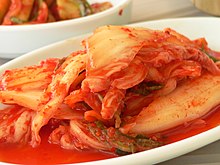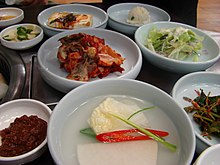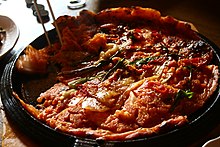Kimchi
| Kimchi | |
 | |
| Korean name | |
|---|---|
| Hangul | 김치 |
| Hanja | |
| Revised Romanization | Gimchi |
| McCune–Reischauer | Kimch'i |
Kimchi, also spelled gimchi or kimchee, is a traditional Korean fermented dish made of some select vegetables with varied seasonings, most commonly referring to the spicy baechu variety. Kimchi is the most common Korean banchan, or side dish, eaten with rice along with other banchan dishes. Kimchi is also a common ingredient and cooked with other ingredients to make dishes such as kimchi stew (kimchi jjigae) and kimchi fried rice (kimchi bokkeumbap).
History

The history of kimchi traces back to ancient times. References to kimchi can be found as early as 2600-3000 years ago.[1] The first text-written evidence of its existence can be found in the first Chinese poetry book, Sikyeong (hangul:시경 hanja:詩經). In this book, kimchi was referred as “Ji”, the term used before it was known as “Chimchae”.[2]
The earliest form of kimchi consisted of only cabbage, and it was in the 12th century when people began to include other spices to create different flavors, such as sweet and sour flavors, and colors of kimchi, such as white and orange.[3]
Chili peppers, now a major ingredient in most forms of kimchi, were unknown in Korea until the early 17th century. Chili peppers originated from the New World and were introduced to East Asia by Western traders.[4] This particular style of kimchi made with chili peppers and baechu, a variety of Chinese cabbage, gained popularity in the 19th century and this baechu kimchi continues to be the most common and popular form of kimchi today.[5]
Composition

Kimchi's composition can be separated into the main vegetable ingredient and the mix of seasonings used to flavor the kimchi. While the most popular type of kimchi is the baechu (a type of Chinese cabbage) variety, many different types exist including regional and seasonal varieties. Popular variants include ggakdugi (hangul: 깍두기) which is a kimchi made with cubed radishes, pa kimchi (made with scallions), and oisobaegi (hangul: 오이 소배기) which is a cucumber kimchi stuffed with hot and spicy seasonings. Ggaennip (hangul: 깻잎) kimchi features layers of perilla leaves marinated in soy sauce and other spices.

The Kimchi Field Museum in Seoul has documented 187 historic and current varieties of kimchi. Although the most common seasonings include brine, garlic, scallions and chili pepper grind, countless varieties of seasoning and ingredients can be replaced or added depending on the type of kimchi being made. Common seasonings also include ginger, onions, low-sodium aekjeot (hangul: 액젓) as well as fruit or fresh seafood. Aekjeot has replaced high-sodium myeolchi jeot and saewoo jeot since the early 1970s.
Kimchi varieties

Kimchi can be categorized by main ingredients, regions or seasons. Korea's northern and southern sections have a considerable temperature difference.[6] Northern regions tend to have longer winters compared to the southern regions of Korea. Kimchi from the northern parts of Korea tend to have less salt as well as less red chilli and usually do not have brined seafood for seasoning. Northern kimchi often has a watery consistency. Unlike northern styles, kimchi in the southern parts of Korea, such as Jeolla-do and Gyeongsang-do, uses salt, chili peppers and myeolchi jeot (hangul: 멸치젓, brined anchovy allowed to ferment) or saewoo jeot (hangul: 새우젓, brined shrimp allowed to ferment), myeolchi aekjeot (hangul: 멸치액젓, liquid anchovy jeot, similar to fish sauce used in Southeast Asia, but thicker). In the Seoul area saewoo jeot is preferred.
Saewoo jeot (hangul: 새우젓) or meyolchi jeot (hangul: 멸치젓) is not directly put into 속(a mixture of spices and seasonings used for Kimchi filling), but normally is boiled at medium heat to deodorize odors, eliminate tannic flavor and fats, and then is mixed with a thickener made of rice or wheat starch (hangul: 풀). But this tedious process of deodorizing has come into oblivion for about 40 years.
Other brined fish jeot can be used, but does not make up the mainstream of kimchi recipes, and modern commercialization has made 액젓 (either 멸치젓 or 새우젓) more affordable and convenient. Depending upon the season of the year, the various weather conditions, and ingredients available in the region, different varieties of kimchi are produced.
White kimchi (baek kimchi) is baechu seasoned without chili pepper and is neither red in color nor spicy. White radish kimchi (dongchimi) is another example of a popular kimchi that is not spicy. The watery white kimchi varieties are a popular ingredient in a number of dishes such as cold noodles in "dongchimi" brine (dongchimi guksu) and is eaten widely during the summer months.
By region
(The entire section's reference)[6]

This regional classification dates back to 1960s and contains plenty of historical facts but the current kimchi-making trends in Korea are generally different than mentioned below.
- Hamgyeong-do (Upper Northeast)
Due to its proximity to the ocean, people in this particular region use fresh fish and oysters to season their kimchi.
- Hwanghae-do (MidWest)
The taste of kimchi in Hwanghaedo can be best described as "moderate" — not bland but not overly spicy. Most kimchi from this region has less color since red chili flakes are not used. The typical kimchi for Hwanghaedo is called pumpkin kimchi (bundi).

- Gyeonggi-do (Lower Midwest of Hwanghaedo)
People use a wide variety of vegetables and seasonings to make kimchi. Gyeonggido kimchi is also well known for its eye-catching decorations.
- Chungcheong-do (Between Gyeonggido and Jeollado)
Instead of using fermented fish, people in the region rely on salt and fermentation to make savory kimchi. Chungcheongdo is known for the greatest varieties of kimchi.
- Gangwon-do (MidEast)
Compared to other regions, it is very typical in Gangwondo to store kimchi for longer periods of time. Unlike other coastal regions in Korea, kimchi in this area does not contain much salted fish.
- Jeolla-do (Lower Southwest)
People use different types of fermented fish, such as salted yellow corvine and salted butterfish to create different seasonings for kimchi.
- Gyeongsang-do (Lower Southeast)
This region is famous for salty and spicy flavors in its dishes and their kimchi is no exception. The most common seasoning components includes myeochi jeot( hangul:멸치젓 ) which produce a briny and savory flavor.
Unlike French wine, kimchi is not commercially classified in terms of vintage and district or Appellation d'origine contrôlée but classification of kimchi by region may seem gradually outdated and lose significance for a variety of reasons.
By season
(The entire section's reference)[7]

- Spring
Traditionally, after a long period of consuming gimjang kimchi ( hangul: 김장김치) during the winter, fresh potherbs and vegetables were popular for making kimchi. These kinds of kimchi were not fermented or even stored for long periods of time but were freshly consumed.
- Summer
Young summer radishes and cucumbers are popular summer vegetables made into kimchi, yeolmu kimchi (hangul: 열무김치) which is eaten in several bites. Brined fish or shellfish can be added and freshly ground dried chili peppers are often used.
- Autumn
Baechu kimchi is the most common type of kimchi in the fall. It is prepared by inserting blended stuffing materials, called sok(literally meaning inside), between layers of salted leaves of uncut, whole cabbage. The ingredients of sok (hangul: 속) can vary, depending on the different regions and weather conditions. Generally, baechoo kimchi used to have a strong salty flavor until late 1960s when a large amount of myeochi jeot or saewoo jeot had been used. Since the advent of aekjeot (hangul: 액젓, Korean fish sauce) in the early 1970s, however, low-sodium kimchi is preferably made both at homes and at factories.
- Winter
Traditionally, the greatest varieties of kimchi were available during the winter. In preparation for the long winter months, many types of kimjang kimchi (hangul: 김장 김치) were prepared in early winter and stored in the ground in large kimchi pots. These days, kimchi refrigerators offering precise temperature controls are used to store gimjang kimchi. It is often November or December when people begin to make kimchi; women often gather together in each others' homes to help with winter kimchi preparations. White kimchi (baek kimchi), is a common and popular kimchi to make during the wintertime. "Baechu kimchi" is made with salted baechu (a type of Chinese cabbage) filled with thin strips of radish, parsley, pine nuts, pears, chestnuts, shredded red pepper, manna lichen (석이버섯), garlic, and ginger.
Nutrition and health
Kimchi is made of various vegetables and contains a high concentration of dietary fiber, while being low in calories. It also provides up to 80% of the daily required amount of ascorbic acid and carotene.[8] Most types of kimchi contain common ingredients like onions, garlic and peppers all of which have well-known health benefits. The vegetables being made into kimchi also contribute to the overall nutritional value. Kimchi is rich in vitamin A, thiamine (B1), riboflavin (B2), calcium and iron,[9][10] and contains a number of lactic acid bacteria. In 2000, a novel bacteriocin-producing lactic acid bacterium (strain MT-1077T) was isolated from Kimchi and was named Lactobacillus kimchi.[11] [12] [13][14]
Kimchi has a reputation of being a healthy food. The US magazine Health named kimchi in its list of top five "World's Healthiest Foods" for being rich in vitamins, aiding digestion, and even possibly retarding cancer growth.[15] However, some research focused on high-sodium dietary dependence has found overconsumption of kimchi and soybean paste ( hangul: 된장 similar to miso ) to be a risk factor in gastric cancer (most likely due to nitrates and salt) while unfermented alliums and unfermented seafood were found to be protective factors.[16] One oncological study found one type of kimchi to be a protective factor against gastric cancer while two other types of such high-sodium kimchi as dongchimi (hangul: 동치미) were risk factors.[17]

| Nutrients | per 100g + | Nutrients | per 100g |
|---|---|---|---|
| Food energy(Kal) | 32 | Moisture(g) | 88.4 |
| Crude protein(g) | 2.0 | Crude Lipid (g) | 0.6 |
| Total sugar(g) | 1.3 | Crude fiber(g) | 1.2 |
| Crude ash (g) | 0.5 | Calcium(mg) | 45 |
| Phosphorus(mg) | 28 | Vitamin A (lU) | 492 |
| Vitamin B1 (mg) | 0.03 | Vitamin B2 (mg) | 0.06 |
| Niacin(mg) | 2.1 | Vitamin C(mg) | 21 |
+per 100g of edible portion
Kimchi in popular culture
This article contains a list of miscellaneous information. (January 2008) |
- Many Koreans store kimchi in a kimchi refrigerator (hangul: 김치냉장고) that is specifically designed with precise controls to keep different varieties of kimchi at optimal temperatures for various stages of fermentation and also for longer storage than in regular fridges.[19]
- The South Korean Korea Aerospace Research Institute (KARI) are hoping to have the first Korean in space to experiment with kimchi while aboard the Russian-manned space ship Soyuz. KARI has developed a space-safe kimchi recipe by sterilizing the food with radiation blasts, heat, freezing and packaging.[20]
- When taking photographs, South Koreans often say the word "kimchi" the same way English speakers would use the word "cheese".[21]
- Gwangju Kimchi Festival is an annual event held in Gwangju city in southern Korea and is open to Koreans and foreign tourists as well.
- In U.S. slang, "kimchi" is occasionally used in the phrase "in deep kimchi", a euphemism for "in trouble". This phrase is particularly common in the U.S. military community, which has had a presence in South Korea since the Korean War.
See also
- Korean cuisine
- Foods containing tyramine
- List of Korea-related topics
- List of English words of Korean origin
- Sauerkraut
- Fermentation (food)
- Napa Cabbage, Wongbok
- Lactobacillus kimchi sp. nov.
References
- ^ Template:Ko icon The origin of the etymology on Kimchi from Kimchi Expo 2003 website
- ^ Template:Ko icon 김치의 이름(명칭) from Hankyorei21
- ^ Kimchi Museum Official Website
- ^ Template:Ko icon =46 "고추". Encyclopedia of Korean national culture. Retrieved 2006-12-09.
{{cite web}}: Check|url=value (help) - ^ History and Development of Kimchi as Korean Food from Tour2Korea
- ^ a b "Kimchi." Yahoo Korean Encyclopedia
- ^ Template:Ko icon "Kimchi in Korea: By Season." Korea Agro-Fisheries Trade Corp.
- ^ Bae, Christina. "Kimchi?Korean Fermented Food." University of Bristol.
- ^ "Food in Korea". Asianinfo.com. Retrieved 2007-01-30.
- ^ "Kimchi". Tour2korea.com. Retrieved 2007-01-30.
- ^ http://ijs.sgmjournals.org/cgi/reprint/50/5/1789.pdf
- ^ Jung-Sook Leea, Gun-Young Heoa, Jun Won Leea, Yun-Jung Oha, Jeong A Parka, Yong-Ha Parka, Yu-Ryang Pyunb and Jong Seog Ahn; Analysis of kimchi microflora using denaturing gradient gel electrophoresis. International Journal of Food Microbiology Volume 102, Issue 2, 15 July 2005, Pages 143-150
- ^ Myungjin Kim and Jongsik Chun; Bacterial community structure in kimchi, a Korean fermented vegetable food, as revealed by 16S rRNA gene analysis. International Journal of Food Microbiology, Volume 103, Issue 1, 15 August 2005, Pages 91-96
- ^ http://ijs.sgmjournals.org/cgi/reprint/50/5/1789.pdf
- ^ Raymond, Joan "World's Healthiest Foods: Kimchi (Korea)" Health Magazine. <http://www.health.com/health/article/0,23414,1149143,00.html>
- ^ Nan et al., Kimchi and soybean pastes are risk factors of gastric cancer <http://www.wjgnet.com/1007-9327/11/3175.pdf>
- ^ Kim et al., Dietary factors and gastric cancer in Korea: A case-control study. International Journal of Cancer 2001; Volume 97, Issue 4, Pages 531-535<http://www3.interscience.wiley.com/cgi-bin/abstract/86513556/ABSTRACT>
- ^ from Korea Food Research Institute
- ^ "High-tech kimchi refrigerators keep Korea's favourite food crisp". Hong Kong Trade Development Council. 2002-03-14. Retrieved 2008-02-14.
- ^ http://www.wired.com/news/technology/0,71607-0.html
- ^ http://www.asianinfo.org/asianinfo/korea/food.htm
External links
- How to make Kimchi (video)
- History and general information about kimchi from The Korean Overseas Information Service
- Korean traditional kimchi
- Korea National Tourism Organization's Kimchi page
- Kimchi Field Museum, Seoul
- Korea Food Research Institute
- General information about kimchi from Life in Korea.com
